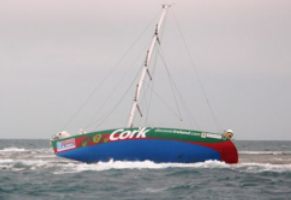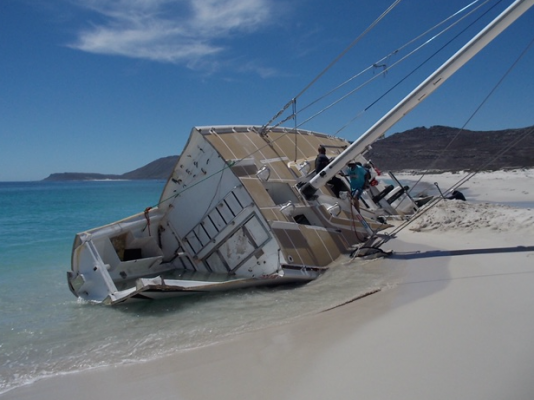MAIB: ‘Insufficent planning’ resulted in Clipper yacht Greenings grounding
The Marine Accident Investigation Branch (MAIB) says lessons learnt from previous incidents could have prevented CV24 running aground in South Africa
‘Insufficient planning’ was behind the grounding of the Clipper Race CV24 yacht, Greenings, according to the Marine Accident Investigation Branch (MAIB).
The vessel ran aground off South Africa on 31 October 2017 during Leg 3 of the round the world race. No one was injured, and the amateur crew were later transferred to other Clipper boats to complete the race.
‘No crew member had been assigned to the navigation station, depth information was not being displayed at the helm and there were no safe cross track distances or safety depths plotted on paper or electronic charts,’ stressed the MAIB in its report into the incident, which was published today.
Clipper Founder and Chairman, Sir Robin Knox-Johnston said it was committed ‘to maintaining the highest possible safety standard across its training and racing.’
He also called for an urgently needed review ‘of regulation and the speed of reporting key learnings’, adding that the lessons for the industry at large were ‘significant’ and it was ‘unreasonable’ to expect individual companies, like Clipper, to ‘path-find on safety without the support and encouragement from the relevant authorities.’

None of the CV24 crew were injured. Credit: Clipper Round the World
The MAIB findings are that at the time of the grounding of CV24, the skipper, the only professional sailor aboard, was responsible for navigation.
Changes in wind speed and direction and an inability to maintain course in 20-25knt north-northwesterly winds led him to order a gybe, which he supervised.
This distraction, said the MAIB, along with no depth information being displayed at the helm and the hazy, dark conditions meant no one foresaw the grounding risk.
The Clipper Race instructions’ advisory warning for all yachts was to remain at least 10 miles offshore at night. It has since introduced compulsory mandatory exclusion zones around all navigational hazards, and no Clipper vessel can roam into less than 20m.
Seven of the 11 other race yachts followed courses similar to CV24’s towards the shore and CV31 almost certainly also grounded, although managed to gybe to alter course.

CV4 after grounding on a reef in Java in 2010
The MAIB also highlighted the lack of an experienced navigator aboard CV24. Provision of this role had been recommended to Clipper in 2010 by the Maritime Claims and Services Ltd, which investigated the grounding of the Clipper yacht CV4 on a reef in Java.
The absence of a second professional sailor, which was recommended to Clipper in 2017 by the MAIB after the deaths of Andrew Ashman and Sarah Young during 2015-16 race, was also raised. ‘With only one professional, employed seafarer on board, the Clipper yachts were not safely manned for the round the world race,’ stated the MAIB in its CV24 grounding report.
Despite the 2017 recommendations, Clipper introduced its Clipper coxswains, who underwent a Maritime and Coastguard Agency-approved training course. It felt they would be able to raise concerns rather than a company employed qualified mate.
The designated Clipper coxswain was off watch at the time of CV24’s grounding.
CV24 was coded Category 0 when undertaking the round the world race, which usually carries a requirement to have a minimum of two crew both holding a commercially endorsed RYA Yachtmaster qualification. There was also a requirement to ensure that there was at all times, a person with adequate experience in charge of the navigational watch.
Clipper, said the MAIB, had negotiated a bespoke agreement with the MCA, allowing this second professional on board to be a Clipper coxswain when a second qualified Yachtmaster was not available.
Continues below…
Clipper Round The World Yacht Race: Greenings salvage operation nearing completion
Less than a month since Greenings ran aground on the opening day of Race 3, the salvage operation to remove…
Clipper Round The World Yacht Race: Greenings out of the race after running aground near Cape Town
Clipper Round The World Race has announced that yacht Greenings will withdraw from the race after it ran aground halfway…
Clipper Round the World Race: Greenings skipper David Hartshorn ‘in good spirits’ after successful operation
Greenings skipper David Hartshorn's suffered a serious injury when his thumb was caught in one of the lines. He received…
After the CV24 incident, the MCA revoked the agreement and Clipper Race immediately introduced additionally qualified mates on board, in addition to the coxswain crew.
It also created an internal Safety Audit Department, led by the Chief Operating Officer and introduced procedure so all passage plans are checked by company staff before each leg.
Investigators also recommended to Clipper that it takes ‘urgent action designed to improve the ability of its skippers and watch leaders to maintain positional awareness while on deck in pilotage and coastal waters’.
Considerations included: the provision of a navigation/chart display on deck by the helm position; more effective use of onboard navigational equipment to avoid danger, including a means for rapid communication between the navigation station and the helm and more clearly defining the duties of the watch navigator.

CV4, Cork before it grounded in 2010
In addition to the grounding and loss of CV4 and CV24, the MAIB holds records of 17 other groundings of Clipper yachts in the 5 years prior to this accident, and one since.
The MAIB report into the CV24 incident also revealed that the skipper failed to make a “Mayday” or “Pan Pan” distress call until 50 minutes after running aground. The race director was informed of the incident 23 minutes after it happened.
The Clipper Round the World Race was established in 1996. Since then, there have been 11 editions, with a total of 97 yacht circumnavigations (a cumulative excess of 4 million nautical miles), over 5000 crew undergoing extensive training, plus the successful running of three Velux 5 Ocean Races.
Commenting, Chairman and founder of Clipper, Sir Robin Knox-Johnston, said: ‘This incident brings up vital learnings for all yachtsmen. As part of our investigations, we were most concerned that a number of yachts were ignoring the race instructions’ advisory warning to remain at least 10 miles offshore at night. As a result of this incident we immediately implemented mandatory exclusion zones around navigational hazards,’ he explained.

Sir Robin Knox-Johnston
‘We also implemented new guidelines to Skippers and our Race Officials are now monitoring the quality of all passage plans going forward. We are confident that these two initiatives will significantly reduce the risk of such an incident occurring in the future.’
‘Clipper Ventures runs a safety management system which exceeds all regulatory requirements and recommendations. As a result, we have been at the forefront of implementing safety initiatives to ocean racing such as AIS beacons on Dan buoys and in Lifejackets, a system now being introduced by World Sailing, double tethers on harnesses, sea survival training for all crew, ISAF survival training, and swimmer assisted MOB recovery using dummies,’ continued the Clipper founder.
‘Nevertheless, we are always looking for ways to improve and continue to review our systems to make sure they remain at the forefront of best practice. The lessons for our industry at large are significant and a review of regulation, and the speed of reporting of key learnings, is urgently required. It is unreasonable to expect individual companies such as Clipper Ventures to path-find on safety without the support and encouragement from the relevant authorities,’ concluded Sir Robin.
Report by Katy Stickland at Yachting Monthly












